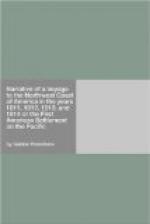I noticed in the month of August another berry growing in bunches or grapes like the currant, on a bush very similar to the currant bush: the leaves of this shrub resemble those of the laurel: they are very thick and always green. The fruit is oblong, and disposed in two rows on the stem: the extremity of the berry is open, having a little speck or tuft like that of an apple. It is not of a particularly fine flavor, but it is wholesome, and one may eat a quantity of it, without inconvenience. The natives make great use of it; they prepare it for the winter by bruising and drying it; after which it is moulded into cakes according to fancy, and laid up for use. There is also a great abundance of cranberries, which proved very useful as an antiscorbutic.
We found also the whortleberry, chokecherries, gooseberries, and black currants with wild crab-apples: these last grow in clusters, are of small size and very tart. On the upper part of the river are found blackberries, hazel-nuts, acorns, &c. The country also possesses a great variety of nutritive roots: the natives make great use of those which have the virtue of curing or preventing the scurvy. We ate freely of them with the same intention, and with the same success. One of these roots, which much resembles a small onion, serves them, in some sort, in place of cheese. Having gathered a sufficient quantity, they bake them with red-hot stones, until the steam ceases to ooze from the layer of grass and earth with which the roots are covered; then they pound them into a paste, and make the paste into loaves, of five or six pounds weight: the taste is not unlike liquorice, but not of so sickly a sweetness. When we made our first voyage up the river the natives gave us square biscuits, very well worked, and printed with different figures. These are made of a white root, pounded, reduced to paste, and dried in the sun. They call it Chapaleel: it is not very palatable; nor very nutritive.
But the principal food of the natives of the Columbia is fish. The salmon-fishery begins in July: that fish is here of an exquisite flavor, but it is extremely fat and oily; which renders it unwholesome for those who are not accustomed to it, and who eat too great a quantity: thus several of our people were attacked with diarrhoea in a few days after we began to make this fish our ordinary sustenance; but they found a remedy in the raspberries of the country which have an astringent property.
The months of August and September furnish excellent sturgeon. This fish varies exceedingly in size; I have seen some eleven feet long; and we took one that weighed, after the removal of the eggs and intestines, three hundred and ninety pounds. We took out nine gallons of roe. The sturgeon does not enter the river in so great quantities as the salmon.
In October and November we had salmon too, but of a quite different species—lean, dry and insipid. It differs from the other sort in form also; having very long teeth, and a hooked nose like the beak of a parrot. Our men termed it in derision “seven bark salmon,” because it had almost no nutritive substance.




